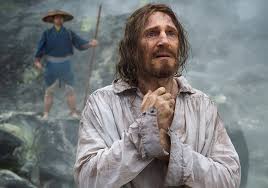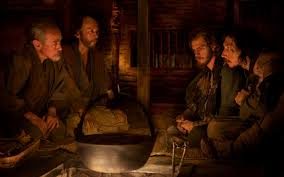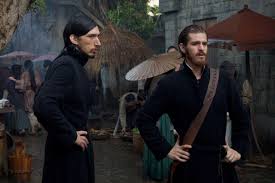Movie Review: Silence

Martin Scorsese’s spiritual quest, which he has referenced in many of his films from Mean Streets through to The Last Temptation of Christ and Kundun, continues with this adaptation of the 1966 novel of the same name by Japanese author Shusaku Endo. Winner of the Tanizaki Prize for Japanese literature, Endo’s most famous work essayed the travails of a young Portuguese Jesuit who, along with his spiritual companion, ventures to 17th century Japan to minister the faith and seek out a famous priest who may or may not have committed apostasy. Andrew Garfield and Adam Driver are the young Jesuit priests in Scorsese’s version of the tale (it has been adapted on previous occasions) who, upon learning of their former mentor’s alleged apostasy in Japan, request that they be allowed go and discover the truth of his fate. They realise the perils of their mission, but, as Scorsese and Jay Cocks script suggests, fail to account for the potential cost of their actions and faith on others. The subject of this quest Father Cristovao Ferreira (a gaunt but effective Liam Neeson) is shown in the film’s bleak opening sequence as he witnesses the horrific torture of other men of the cloth. Rodrigues (Garfield) and Garupe (Driver), accompanied by a guilt-laden fisherman named Kichijiro, arrive in a peasant village where a glimmer of hope seems to flourish at first. The two men tend to their spiritual duties by baptising young and old alike and passing out artefacts of their faith to the underground Christian community. But an ever-present threat looms over their heads and it’s not long before the intolerant regime is pursuing the priests by way of the torture and execution of its very own citizens.

This is one of the central themes which Silence examines in its 161-minute running time: Is it a sin to recant one’s own faith on the surface in order to alleviate the suffering, nay even save the lives of others? At a relatively early juncture in the film Rodrigues and Garupe witness first-hand the torture and subsequent deaths of three men who are strapped to wooden crosses and subjected to the torrent of ocean waves. Garfield’s voice-over (employed on many such occasions throughout the course of the film) informs us that the final man to die lasted a full four days. This latter revelation more than suggests that the two priests remain in hiding throughout this ordeal. But what of action on their part? What of surrendering to the repressive shogunate? Later, when captured by the aforementioned regime, Rodrigues observes on the somewhat benevolent treatment he receives from his captors – three square meals a day and a quiet period of time for contemplation. And yet, on the other hand, he watches on as his fellow Christian prisoners are forced to dig holes in the prison courtyard as the incessant rain falls around them. Worse is to follow with a beheading and the drowning of several prisoners, and Garupe, at sea. Neeson’s Ferreira eventually reappears with a new name and an avowed doctrine. ‘Mountains and rivers can be moved,’ he tells a distressed Rodrigues, ‘but man’s nature cannot be moved.’ The eventual denouement comes as Rodrigues’s fellow inmates are slowly put to death in a fashion which Ferreira himself had once experienced. I won’t reveal what happens beyond this point as you may very well wish to see the film for yourselves. But be warned. It’s long and it takes a very circuitous route in conveying its message.

From all evidence Silence has been a long-cherished project of the director for years and one cannot but admire the fervour the 74-year-old Scorsese brings to bear on his subject matter. But here indeed may be one of the central failings of Silence. It’s all a bit too reverent and respectful of its themes and core story to the detriment of nuance or subtlety. Andrew Garfield (central right to the film’s final frame) and Adam Driver (less prominent) do well enough as the Jesuits, but one senses a restraint in their performances which extends to the film as a whole. The photography of Mexican cinematographer Rodrigo Prieto is functional and understated. Although reminiscent in many ways of Roland Joffe’s 1986 The Mission (which, incidentally also featured Neeson in a supporting role), Silence does not have the expansive range of Chris Menges’ Oscar-winning cinematography. The musical score is muted at best, non-existent in fact for most of the duration. Long-time Scorsese collaborator Thelma Schoonmaker’s editing is similarly inhibited. The camera and dialogue ponder on the weighty themes the director explores and it all becomes a little one-note even as Neeson’s fallen priest finally encounters Garfield. This is not to say that Silence is a bad film, but it is a very slow and rather laborious journey to an eventual conclusion which…well I really shouldn’t say. Go see the film if you have an innate interest in the moral debate it seeks to engender. But as I said, there is a health warning here. It takes its time in the process. It takes a good deal of time. And silence literally attends those end credits.
Rating: C